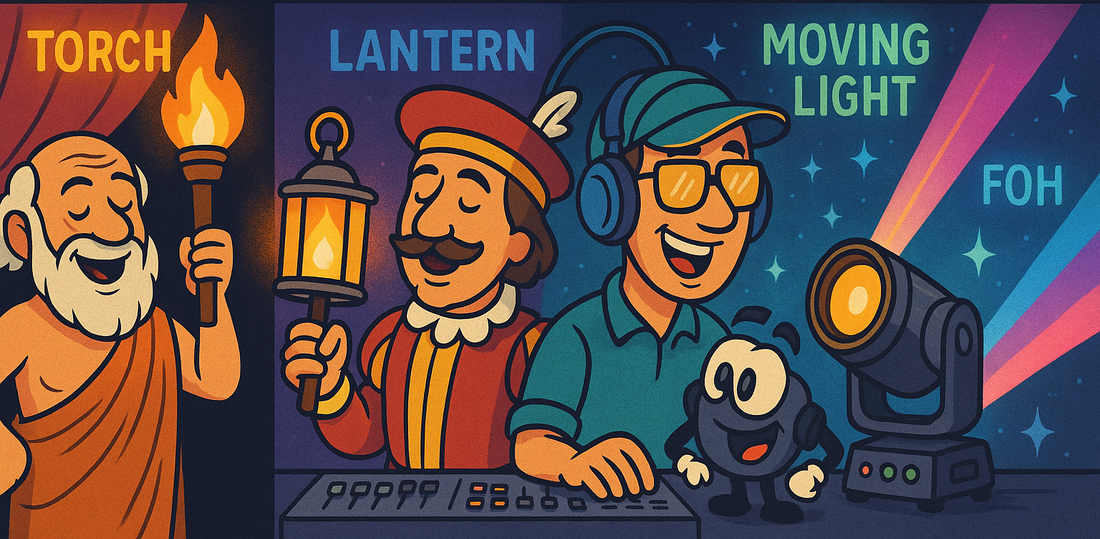
A History of Theatrical and Stage Lighting
Share
The evolution of theatrical lighting is a rich narrative of technological innovation, artistic expression, and cultural transformation. From ancient fires to modern digital control systems, the tools and techniques used to illuminate the stage have shaped how stories are told and experienced by audiences across time.
Origins in Antiquity
The earliest form of stage lighting can be traced back to ancient Greece in the 5th century BCE. Greek amphitheaters, such as the Theater of Dionysus in Athens, were built outdoors and oriented to make use of natural sunlight. Performances were held during the day, and playwrights and architects worked in harmony to leverage sunlight angles for dramatic effect. Reflective surfaces and rudimentary shading techniques were occasionally employed to enhance or dim lighting naturally.
Medieval and Renaissance Developments
During the Middle Ages, theatrical performances were often tied to religious rituals and were staged in churches or temporary outdoor platforms. Lighting remained natural, with minimal enhancements.
The Renaissance brought a renewed interest in arts and architecture, and with it, more sophisticated staging. Indoor theaters like the Teatro Olimpico in Italy (built in 1585) used candles and oil lamps as the primary sources of illumination. Reflectors and colored glass began to appear, introducing early attempts at controlling and stylizing light for artistic effect. However, fire hazards and the intensity of candlelight limited their effectiveness.
The 17th and 18th Centuries: Candle and Oil Illumination
By the 17th century, theatrical lighting began to evolve significantly. Candles were placed in footlights, chandeliers, and wall sconces. Oil lamps were added to improve brightness. Lighting became a tool to support mood and focus the audience's attention. By the 18th century, snuffers and mechanical dimming devices enabled rudimentary lighting control.
Innovators like Nicola Sabbatini documented methods for stage lighting, including using metal reflectors and colored liquids in glass vessels to create mood lighting. These developments laid the groundwork for modern lighting design.
The Gaslight Era: Early 19th Century
The invention of gas lighting in the early 1800s revolutionized theater. The first gas-lit theater was London’s Lyceum Theatre in 1803. Gaslight allowed for brighter, more consistent lighting and greater control over intensity and placement.
However, gaslight introduced new risks, including fire and poor air quality. Still, it marked a critical turning point. The use of limelight (created by heating a piece of lime in an oxyhydrogen flame) was introduced in the 1820s. Limelight became the first spotlight and could be focused on specific areas or actors, enhancing stage direction and dramatic emphasis.
The Advent of Electricity: Late 19th Century
Electric lighting entered the theatrical world in the late 1800s, eliminating many dangers posed by gas. The Savoy Theatre in London became the first fully electrified venue in 1881. Theaters quickly embraced electric arc lamps and incandescent bulbs.
Electricity allowed for safer and more sophisticated lighting systems. Designers could dim lights without smoke, create dynamic effects, and focus beams with unprecedented precision. The concept of "blackouts" and "fades" became common, allowing seamless transitions between scenes.
The 20th Century: Technology Meets Art
The 20th century saw lighting evolve into an expressive art form. The introduction of the Fresnel lens, ellipsoidal reflector spotlights (ERS), and PAR cans provided versatile and controllable tools. Dimmer boards and patch panels allowed designers to craft lighting with nuance and complexity.
By mid-century, lighting became a formal discipline in theater production. Designers like Jean Rosenthal and Tharon Musser helped define the field, treating lighting as a storytelling device on par with set, costume, and sound design.
The 1960s and 70s brought computer-controlled dimming systems, enabling precise, repeatable cues. The rock concert industry further pushed lighting innovation with the rise of moving lights, color changers, and rigging automation.
The Digital Age and LED Revolution
Today, stage lighting is a digital marvel. Lighting consoles use sophisticated software to control thousands of fixtures with pinpoint accuracy. LED technology has replaced many traditional sources, offering energy efficiency, longevity, and color versatility.
Moving lights, pixel mapping, and programmable effects are now standard. Wireless DMX control, real-time 3D visualizers, and integration with video and projection systems have expanded creative possibilities exponentially.
Designers use previsualization tools to plan entire lighting plots virtually before setting foot in a theater. Lighting has merged with multimedia, becoming central to immersive and interactive productions.
Conclusion
The history of stage lighting is a journey from sunlight to software. It is a story of ingenuity, risk-taking, and the relentless pursuit of better ways to enhance theatrical storytelling. As technology continues to evolve, so too will the tools of the lighting designer. Yet the core goal remains unchanged: to bring the stage to life and guide the audience through the emotional landscape of performance.
